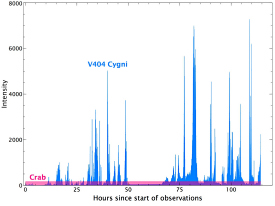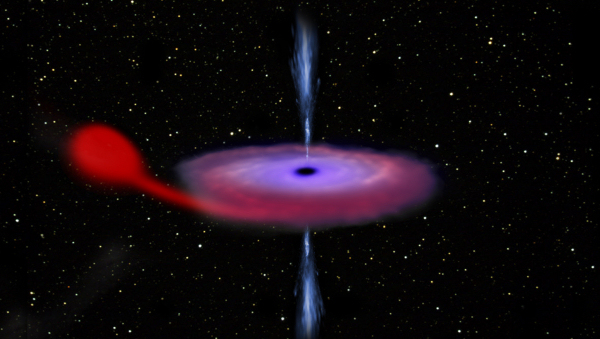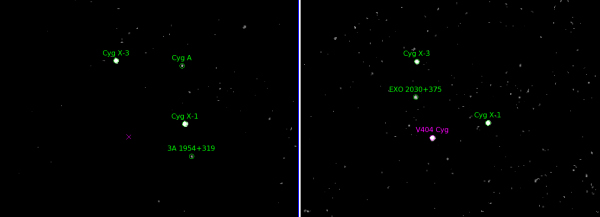Monster black hole wakes up after 26 years
25 June 2015
Over the past week, ESA's INTEGRAL satellite has been observing an exceptional outburst of high-energy light produced by a black hole that is devouring material from its stellar companion.X-rays and gamma rays point to some of the most extreme phenomena in the Universe, such as stellar explosions, powerful outbursts and black holes feasting on their surroundings.
In contrast to the peaceful view of the night sky we see with our eyes, the high-energy sky is a dynamic light show, from flickering sources that change their brightness dramatically in a few minutes to others that vary on timescales spanning years or even decades.
On 15 June 2015, a long-time acquaintance of X-ray and gamma ray astronomers made its comeback to the cosmic stage: V404 Cygni, a system comprising a black hole and a star orbiting one another. It is located in our Milky Way galaxy, almost 8000 light-years away in the constellation Cygnus, the Swan.
In this type of binary system, material flows from the star towards the black hole and gathers in a disc, where it is heated up, shining brightly at optical, ultraviolet and X-ray wavelengths before spiralling into the black hole.
First signs of renewed activity in V404 Cygni were spotted by the Burst Alert Telescope on NASA's Swift satellite, detecting a sudden burst of gamma rays, and then triggering observations with its X-ray telescope. Soon after, MAXI (Monitor of All-sky X-ray Image), part of the Japanese Experiment Module on the International Space Station, observed an X-ray flare from the same patch of the sky.
These first detections triggered a massive campaign of observations from ground-based telescopes and from space-based observatories, to monitor V404 Cygni at many different wavelengths across the electromagnetic spectrum. As part of this worldwide effort, ESA's INTEGRAL gamma-ray observatory started monitoring the out-bursting black hole on 17 June.
"The behaviour of this source is extraordinary at the moment, with repeated bright flashes of light on time scales shorter than an hour, something rarely seen in other black hole systems," comments Erik Kuulkers, INTEGRAL project scientist at ESA.
"In these moments, it becomes the brightest object in the X-ray sky – up to fifty times brighter than the Crab Nebula, normally one of the brightest sources in the high-energy sky."
The V404 Cygni black hole system has not been this bright and active since 1989, when it was observed with the Japanese X-ray satellite Ginga and high-energy instruments on board the Mir space station.
"The community couldn't be more thrilled: many of us weren't yet professional astronomers back then, and the instruments and facilities available at the time can't compare with the fleet of space telescopes and the vast network of ground-based observatories we can use today. It is definitely a 'once in a professional lifetime' opportunity," adds Kuulkers.
The 1989 outburst of V404 Cygni was crucial in the study of black holes. Until then, astronomers knew only a handful of objects that they thought could be black holes, and V404 Cygni was one of the most convincing candidates.
A couple of years after the 1989 outburst, once the source had returned to a quieter state, the astronomers were able to see its companion star, which had been outshone by the extreme activity. The star is about half as massive as the Sun, and by studying the relative motion of the two objects in the binary system, it was determined that the companion must be a black hole, about twelve times more massive than the Sun.
At the time, the astronomers also looked back at archival data from optical telescopes over the twentieth century, finding two previous outbursts, one in 1938 and another one in 1956.
These peaks of activity, which occur every two to three decades, are likely caused by material slowly piling up in the disc surrounding the black hole, until eventually reaching a tipping point that dramatically changes the black hole's feeding routine for a short period.
"Now that this extreme object has woken up again, we are all eager to learn more about the engine that powers the outburst we are observing," says Carlo Ferrigno from the INTEGRAL Science Data Centre at the University of Geneva, Switzerland.
"As coordinators of INTEGRAL operations, Enrico Bozzo and I received a text message at 01:30 am on 18 June from our burst alert system, which is designed to detect gamma-ray bursts in the INTEGRAL data. In this case, it turned out to be 'only' an exceptional flare since INTEGRAL was observing this incredible black hole: definitely a good reason to be woken up in the middle of the night!"
Since the first outburst detection on 15 June by the Swift satellite, V404 Cygni has remained very active, keeping astronomers extremely busy. Over the past week, several teams around the world published over twenty Astronomical Telegrams and other official communications, sharing the progress of the observations at different wavelengths.
This exciting outburst has also been discussed by astronomers attending the European Week of Astronomy and Space Science conference this week in Tenerife, sharing information on observations that have been made in the past few days.
 |
|
INTEGRAL light curve of V404 Cygni. Credit: ESA/INTEGRAL/IBIS/ISDC |
INTEGRAL too has been observing this object continuously since 17 June, except for some short periods when it was not possible for operational reasons. The X-ray data show huge variability, with intense flares lasting only a couple of minutes, as well as longer outbursts over time scales of a few hours. INTEGRAL also recorded a huge emission of gamma rays from this frenzied black hole.
Because different components of a black-hole binary system emit radiation at different wavelengths across the spectrum, astronomers are combining high-energy observations with those made at optical and radio wavelengths in order to get a complete view of what is happening in this unique object.
"We have been observing V404 Cygni with the Gran Telescopio Canarias, which has the largest mirror currently available for optical astronomy," explains Teo Muñoz-Darias from the Instituto de Astrofísica de Canarias in Tenerife, Spain.
Using this 10.4-m telescope located on La Palma, the astronomers can quickly obtain high quality spectra, thus probing what happens around the black hole on short time scales.
"There are many features in our spectra, showing signs of massive outflows of material in the black hole's environment. We are looking forward to testing our current understanding of black holes and their feeding habits with these rich data," adds Muñoz-Darias.
Radio astronomers all over the world are also joining in this extraordinary observing campaign. The first detection at these long wavelengths was made shortly after the first Swift alert on 15 June with the Arcminute Microkelvin Imager from the Mullard Radio Astronomy Observatory near Cambridge, in the UK, thanks to the robotic mode of this telescope.
Like the data at other wavelengths, these radio observations also exhibit a continuous series of extremely bright flares. Astronomers will exploit them to investigate the mechanisms that give rise to powerful jets of particles, moving away at velocities close to the speed of light, from the black hole's accretion disc.
There are only a handful of black-hole binary systems for which data have been collected simultaneously at many wavelengths, and the current outburst of V404 Cygni offers the rare chance to gather more observations of this kind. Back in space, INTEGRAL has a full-time job watching the events unfold.
"We have been devoting all of INTEGRAL's time to observe this exciting source for the past week, and we will keep doing so at least until early July," comments Peter Kretschmar, ESA INTEGRAL mission manager.
"The observations will soon be made available publicly, so that astronomers across the world can exploit them to learn more about this unique object. It will also be possible to use INTEGRAL data to try and detect polarisation of the X-ray and gamma ray emission, which could reveal more details about the geometry of the black hole accretion process. This is definitely material for the astrophysics textbooks for the coming years."
Notes for Editors
The International Gamma-ray Astrophysics Laboratory INTEGRAL was launched on 17 October 2002. It is an ESA project with the instruments and a science data centre funded by ESA Member States (especially the Principal Investigator countries: Denmark, France, Germany, Italy, Spain and Switzerland), and with the participation of Russia and the USA. The mission is dedicated to spectroscopy (E/∆E = 500) and imaging (angular resolution: 12 arcmin FWHM) of celestial gamma-ray sources in the energy range 15 keV to 10 MeV with concurrent source monitoring in the X-ray (3–35 keV) and optical (V-band, 550 nm) wavelengths.





